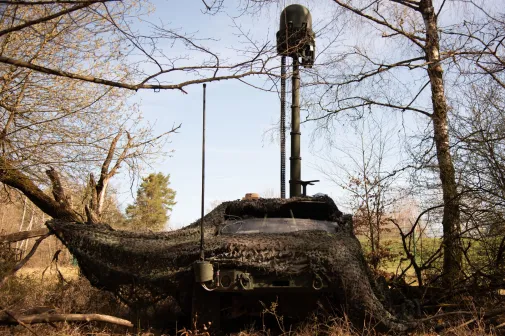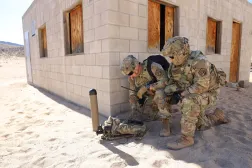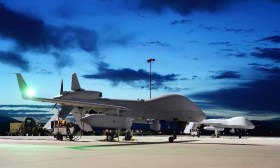
FORT JOHNSON, La. — Commercially available technology, operationalized in the right manner, is yielding tactical advantages for soldiers, Army units discovered during a recent exercise.
During its rotation at the Joint Readiness Training Center at Fort Johnson, Louisiana — a culminating event that is a grueling campaign distilled into 14 days of the most realistic combat simulation the Army can produce and serves as a validation event — 2nd Brigade, 101st Airborne Division strapped $30 dollar raspberry pi’s to small drones and used them as electronic decoys against its enemy, to great effect.
This is an example of how the service is looking to empower bottom-up innovation from soldiers to help inform new tactics on the battlefield and technology approaches that could yield novel capabilities or ways of doing business. It’s part of what the Army calls transforming-in-contact, where the service plans to use deployments and troop rotations to test new equipment — mainly commercial off-the-shelf gear — that could allow units to be more responsive on a dynamic battlefield.
Three areas where the Army needs to be faster and more adaptable when it comes to delivering equipment to forces, due to how challenging the threat environment is and the cat-and-mouse aspect of countering opponents’ moves, are unmanned aerial systems, counter-UAS and electronic warfare, according to senior leaders.
Overall, the service is trying to leverage more commercial-off-the-shelf capabilities that are easy to use, rapidly introduce into them formations and let troops employ them and innovate. This is much faster than traditional acquisition processes that can take years to get systems into the hands of soldiers.
This approach is becoming especially prominent in the electronic warfare realm.
“The pendulum consistently swings. And we’re going back towards the need and the desire to get equipment, limited prototypes, in the hands of units very quickly so that they can learn, they can iterate, and we can get early, good-enough capability out to the field,” Kenneth Strayer, project manager for electronic warfare and cyber at program executive office for intelligence, electronic warfare and sensors, said in a recent interview. “We’re looking at off-the-shelf. We don’t want to do all the development in-house. I don’t think we need to because there’s now a competitive marketplace out there to be able to buy ready products or things that need minor modification and integration. Long, long list of vendors who are offering some very effective capability for remote sensors and [software-defined radios] and digitization.”
The Army is now trying to rely less on major programs that take years to develop through lengthy requirements, tweaks and user tests, shifting the way it talks about strategies and prioritization. But Strayer declined to quantify the ratio or percentage of commercial versus major government-run programs in the future. In some cases, though, these high-end systems are necessary to build for specific needs.
Military officials often point to the creative ways in which technologies available to all can be operationalized for great effect, pointing to Germany’s “blitzkrieg” during World War II.
“Some of you have probably heard some Army senior leaders talk about in the lead-up to World War II, all armies had planes, they had tanks and they had radios, but it was the ability to be able to bring those three together in the opening moves of World War II [that] gave the Germans the advantage. It’s not just about having single pieces [of technology, but also the ability] to bring them together,” Maj. Gen. Brett Sylvia, commander of the 101st Airborne Division, told reporters during a trip to the Joint Readiness Training Center at Fort Johnson.
2nd Brigade, 101st got the idea to build and deploy these raspberry pi-equipped decoys, in part, from its sparring partner, 1st Battalion, 509th Infantry Regiment, know as “Geronimo” — a unit that’s also helping shape the service’s vision for future technologies and concepts given it must compete against Army brigades every month.
The concept was pretty novel: cheap, commercially available circuit boards that can be loaded with certain electronic signatures — such as the brigade’s command post or a commander’s cell phone — and strapped to a drone with a power source to direct the enemy’s attention away from the unit.
“The thing that surprised me was actually the effectiveness of the decoys that were put out … I underestimated, personally, the effectiveness that we would see out there. It really did create some real dilemmas for [the enemy] during this fight,” Sylvia, told reporters. “A tactical advantage there, because he has to unmask his guns in order to be able to execute that fire mission.”
During the JRTC rotation, 2nd Brigade created a battalion and a company headquarters signature and placed them on the decoys. While only one battalion was maneuvering, the decoys depicted to the enemy that there were two in the area. As a result, the real battalion did not use any electronic emissions, allowing it to effectively hide from the enemy.
The decoys tricked the Geronimo force, in one instance, into spending about 50 percent of its artillery targeting what it thought was one of 2nd Brigade’s units, but in fact, was just dirt. The adversary expended valuable munitions for naught and made it easier to locate given it exposed its position with its artillery.
In another instance, a battalion had sent the decoys out, making the enemy think the unit was deeper than it actually was and forcing Geronimo to again expend resources trying to destroy it.
Similarly, troops were able to devise a related capability to pick up the signatures in the environment, which also provided critical information for their own formations.
“That picture that’s above it that has all those SSIDs and it says 2nd brigade TOC … that was when we flew it over ourselves during our last training event so we could pick up whether someone had a Garman on or whether they had a WiFi puck going, or even anything that was just kind of emitting one of those symbols, in order to be able to figure out what was our level of discipline for emissions control and what did our electromagnetic signature look like,” Sylvia said. “Now we can do the same over our adversaries — fly it over them in order to be able to identify a command post. Once you start getting a cluster of those SSIDs, you can make a good assumption about whether or not you’ve been able to identify a command post or not, and then be able to generate a fire mission.”
The Army has been pursuing decoys for some time. There’s a raft of big, program-of-record equipment being developed and planned over the next several years. These commercial tools aren’t expected to necessarily replace those larger programs of record, according to some officials, as those larger systems are more purpose-built. However, commercial systems provide more options to commanders and units and are cheaper, allowing them to be developed faster.
“During the [joint forceable entry], Geronimo launched artillery and into dirt because there was decoys there that they wanted to destroy,” Capt. Charles O’Hagan, commander of the multifunctional reconnaissance company within 2nd Brigade — a prototype formation — told reporters. “Those have been proven great. We get in the enemy commander’s decision-making process and his targeting process, which just gives us maneuver space to counter.”
These types of low-cost, commercial technologies that can be easily purchased and easily used, also present interesting questions regarding how the Army buys capabilities and outfits units. In this case, it was soldier innovation that led to the purchasing and development, but systems must be accounted for and budgeted in a large Army, a process known as Modified Table of Organization and Equipment, or MTOE — an authorization document for personnel and equipment, establishing requirements given a specific doctrinal mission.
Officials said they probably won’t use MTOE for something like $30 raspberry pi’s, equating it to ammunition and noting that it’s difficult to figure out how much a unit will need.
This exercise and bridge will help determine the right number in the future that can be fed into big Army for materiel and operations and maintenance considerations, to put it into the electronic warfare portfolio and program outline.
The service is also taking valuable lessons on when to deploy these types of capabilities given the importance of not spewing them into the environment and risking their effectiveness due to overuse.
“It has to be controlled chaos, because if you’re too obvious, which we thought about over and over again, then it wouldn’t do us any good,” O’Hagan said.
On the flip side, the unit is also taking lessons on how to combat such decoys if they’re deployed against it, so it can avoid making the same mistakes Geronimo did.
“Emerging technology on the battlefield presents opportunities and challenges, and we are learning how to adapt to rapid changes. Without getting into specific TTPs and capabilities, we use cross-queuing between EW and other collection assets to verify targets to enable our targeting process,” a spokesperson for the 101st Airborne Division said. “For example, if we detect something with EW (a tip) we can queue another asset (UAS, signal collection, AI and human analysis) to verify before shooting it. There are multiple means to find the ‘needle in a stack of needles’ with a high degree of speed and accuracy.”






